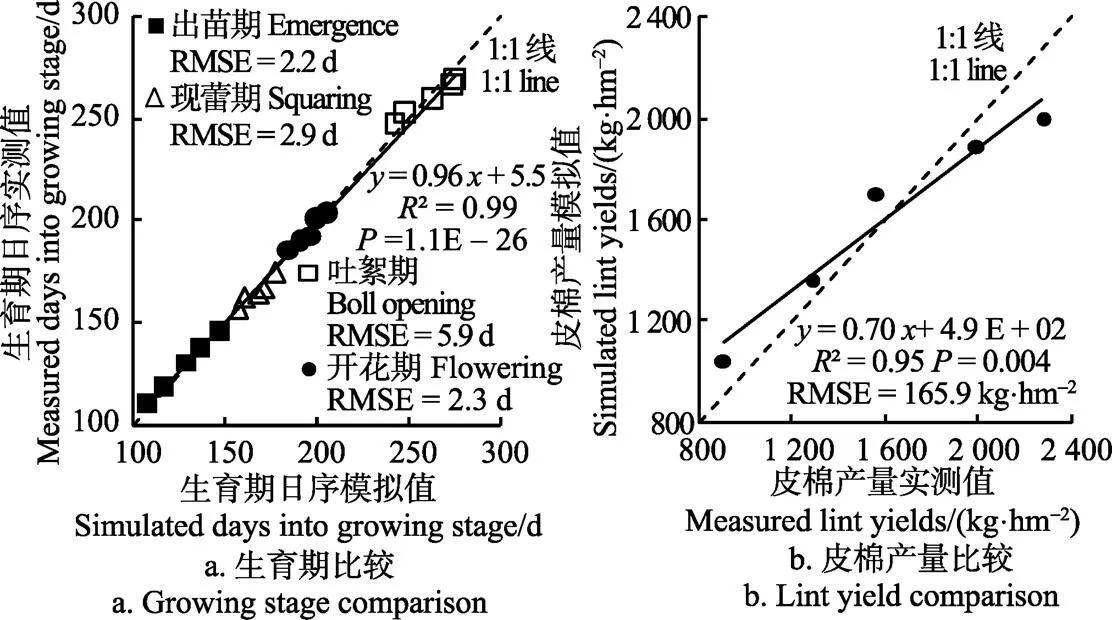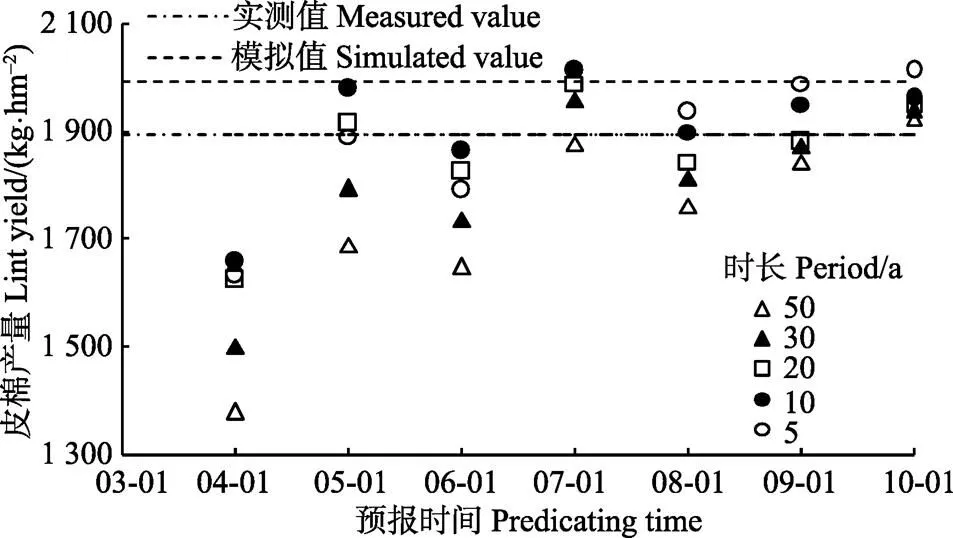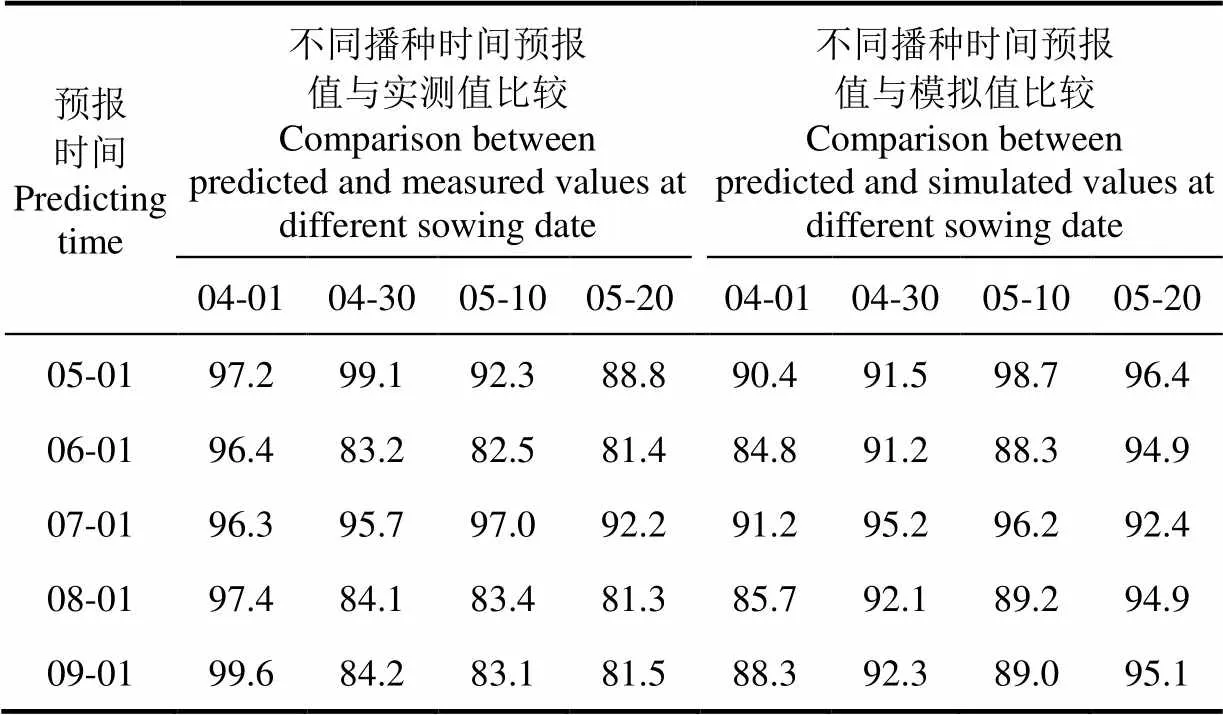基于COSIM模型的新疆棉花产量动态预报方法
王雪姣,潘学标,王 森,胡莉婷,郭燕云,李新建
基于COSIM模型的新疆棉花产量动态预报方法
王雪姣1,2,潘学标2※,王 森1,胡莉婷2,郭燕云1,李新建1
(1. 新疆农业气象台,乌鲁木齐 830002;2. 中国农业大学资源与环境学院,北京 100193)
该文在对棉花生长模拟模型COSIM进行模型调试、验证实现本地化应用的基础上,探讨运用作物模型进行棉花产量动态预报的方法,重点解决未知气象数据替代问题。作物模型应用于产量预报时,未来天气的不确定性是影响预报准确率的关键因子,该影响随着当年实际天气数据增多而减小。该文以近50 a的气象数据,依次替代预报日至收获期的气象数据(即预报日之前使用预报年当年气象数据,预报日之后使用替代年气象数据),模拟棉花生长发育和产量形成过程,以近50、40、30、20、10、5 a历史气候数据依次替代预报日之后的逐日数据获得的模拟产量平均值作为预报产量,根据对预报准确率进行比较,最终确定以近10 a实测数据替代获得的模拟产量平均值作为最终预报产量。经验证该预报方法对不同播种时间棉花产量动态预报的准确率在81.3%~99.6%,预测精度较好。作为案例分析,该文仅进行每月1次预测分析,实际应用中可进行逐日替代动态预报,经过进一步改进,提高预报精度,未来可望达到业务应用水平。
棉花;模型;气象;动态预报;产量;新疆
0 引 言
作物产量预报是农业气象业务的重要组成部分,及时、准确地预测作物长势和产量对于国家宏观调控、进出口政策、农业生产管理等都有指导作用。针对不同的作物,学者们运用统计模型[1-5]、作物模型[6-9]、遥感与作物模型耦合[10-14]等方法开展了大量产量预报研究。
棉花是中国主要的经济作物,新疆是中国最大的优质棉主产区,其棉花产量占全国棉花总产的50%以上[15],因此新疆棉区棉花产量预报的准确性就显得尤为重要。目前,常用的作物产量预报方法中,大田调查统计的方法只能根据当前作物生长发育状况进行估产,预测精度受后期天气因素和样本代表性影响较大,且需要消耗大量人力物力,不适合大面积应用。农业气象统计模型预报方法,只考虑了气象因子对作物产量的影响,模型难以外推应用,且短期内筛选预报因子较为不易,不适于动态预报。遥感技术在大范围的作物估产中有较大优势,但是遥感数据的质量受天气条件影响较大,且只能通过外部表现来反应作物的生长状态,难以了解作物内在生长发育和产量形成过程。此外,运用遥感进行产量动态预测时,预测步长受卫星运行周期限制。相比之下,作物模型不仅揭示了作物生长发育的内在机理,且综合考虑了气候、土壤、管理措施和品种对作物生长发育的影响,能够在任意时间模拟作物产量形成过程[16],近年来被广泛应用于作物产量动态预报[6-9]。作物产量预报过程中,未来天气的不确定性是影响预报准确率的关键因子,该影响随着作物生长发育进程的继续和当年实际天气增多而减小。目前常用于未知天气数据替代的有天气发生器和相似年型。其中,天气发生器[17]能够通过已知天气数据模拟未来的气象特征,可以生成任意长度逐日的天气数据系列。各国学者做了大量研究,针对不同的应用目标,开发了不同类型的天气发生器[18-19]。但由于天气发生器参数调控方法的不足,目前应用其模拟数据进行产量预报仍存在一些不确定性。相似年型是替代未知气象数据的主要来源,目前已有大量研究根据相似年型进行产量预报[20-23],以综合聚类法克服根据单一相似年型预测产量的不足之处。但棉花具有无限生长性,如遇非致命灾害具有可恢复性,即使产量预报前的气象条件与历史某年相似,预报日至收获时的气象条件也不一定相似,从而影响根据相似年型预报出的产量准确性,且近年来极端天气事件频发,大大增强了预报至收获期气象条件的未知性。因此,本文以新疆棉区代表性站点乌苏县为例,探索运用COSIM棉花生长模拟模型[20]进行棉花产量动态预测的方法,重点探讨产量预报过程中未知气象数据的替代问题,以期为农业气象业务服务提供新方法。
1 材料与方法
1.1 试验地概况与试验设计
2011年田间试验在新疆乌苏(44°43′N,84°67′E)进行,属于温带大陆性干旱气候,无霜期195 d、≥10 ℃积温4 002.3 ℃、日照时数1 936.9 h、棉花生长季(4—10月)降水量139.8 mm。2011年4—10月≥10 ℃积温、日照时数和降水量分别为4 235.6 ℃、1 965.3 h和146.8 mm。试验区土壤为黏壤土,土壤容重为1.41 g/cm3、田间持水率为40%(体积含水率)、土壤有机质为15 g/kg、全氮质量分数为0.91%、碱解氮为54 mg/kg、速效磷为5 mg/kg、速效钾为280 mg/kg、pH值为7.8,土壤属于轻度盐碱土。
试验设置5个播期处理,分别为4月10日、4月20日、4月30日、5月10日、5月20日。小区10 m´2 m,南北行向,采用完全随机区组设计,设置3个重复。供试品种为冀棉958(L.),采用播种覆膜滴灌带铺设一次完成的种植模式,1膜种植4行棉花,滴灌带铺设在宽行的2行棉花中间,行距依次为10、60和10 cm,播种密度为22.5 万株/hm2。播种后灌出苗水40 mm,此后,6月上旬开始灌水,8月下旬结束灌水,灌水间隔约为10 d,遇降雨天气灌水日期顺延,5个播期处理累计灌水量分别为366、360、348、320和295 mm。肥料施用量参考当地常规用量,尿素为675 kg/hm2、磷酸二铵为255 kg/hm2、硫酸钾为75 kg/hm2,除出苗水外,每次灌水均随水滴肥,单次施肥量为总施肥量的1/9。5个播期处理分别于9月10日、9月15日、9月21日、9月29日、10月5日开始分3次收获棉花(由于棉花自下而上、自内而外的生长习性,最先结铃的下部棉铃先吐絮成熟,最晚结铃的顶部棉铃最后吐絮成熟,整株棉铃全部成熟历时1个月以上。因此,试验过程中,随着棉铃的成熟,每个播期分3次收获。)。
1.2 测定项目与方法
生育期:以全小区50%棉株达到发育要求为标准,记录棉花播种、出苗、现蕾、开花、吐絮出现的时间。
叶面积和干物质:每30 d在各小区随机取样5株,用长宽比法测定全株叶面积;将棉株各器官分离称鲜质量,而后分别装于纸袋,在105 ℃下杀青30 min后,在80 ℃下烘干至质量恒定,分别测定各器官干物质量。
产量及其构成要素:收获期在各小区随机选取10株,测定单株铃数、铃质量和衣分;选取各小区中间5 m的区域测定籽棉产量。
1.3 作物模型
COSIM模型[24]借鉴COTGROW棉花模型[25-26]的建模理论,主要包括发育期模拟、干物质分配、水分平衡模拟、光合生产、产量形成等模块,其中发育期模拟以温度为变量(>12 ℃有效积温)计算发育速率,根 据群体对太阳辐射的吸收量和辐射能转化率计算干物质生产量,通过各器官质量占总干物质质量的比例得到各器官质量。该模型能够反应环境因子(天气和土壤)、管理措施和品种特性的互作效应对棉生长发育、产量形成的影响,模拟输出棉花各发育期出现时间和单位面积籽棉产量、皮棉产量等。目前,该模型在棉花冷害指标分析、预测和诊断[27-28],以及气候变化对棉花生产的影响方面[29-30]已得到广泛应用。基于多年研究成果建立的新疆棉区土壤和棉花品种信息数据集[31],可为应用该模型进行农业气象业务服务提供数据支持。此外,COSIM模型以日为步长动态模拟棉花生长过程,可实现棉花产量逐日动态预报。
本研究中试验地气象资料(日最高温、日最低温、日照时数、降水量)由国家气象信息中心提供,模型模拟所需的土壤、管理措施和棉花品种信息由田间试验获得。采用均方根误差(root mean square error,RMSE)对实测值和模拟值的吻合程度进行统计分析。

式中RMSE为均方根误差;X为观测值;Y为模拟值;为样本数量。
1.4 基本原理和方法
未来天气的不确定性是影响预报准确率的关键因子,目前还难于准确预报未来月尺度的天气,而获取各地实时的实测气象数据对气象部门已不是难事。本研究用近50 a的气象数据依次替代预报日至收获期的气象数据(即播种至预报日使用当年实测气象数据,预报日至收获日用历史各年气象数据替代)生成50个天气文件,运用模型依次读取天气文件模拟棉花产量,以距预报年最近的50、30、20、10、5 a逐年气象数据替代所得到的模拟产量的平均值作为预报产量。最终根据预报准确率选定预报方法。
2 结果与分析
2.1 模型适应性分析
在COSIM模型输入2011年天气数据,模拟棉花生长发育及产量,利用田间分期播种试验的生育期和产量实测资料对模型模拟结果进行有效性验证。由图1可知,模拟得到的棉花生育期出现日期和皮棉产量与实测值拟合较好。出苗期、现蕾期、开花期和吐絮期日序的观测值和模拟值的RMSE分别为2.2、2.9、2.3和5.9 d,其中吐絮期模拟偏差较大,主要原因是,田间试验后期对5月10日和5月20日2个播期较晚的处理采用了少量乙烯利催熟,导致吐絮期观测值略大于模拟值。皮棉产量观测值与模拟值的RMSE为165.9 kg/hm2,模拟准确率为90%(RMSE为观测值和模拟值的绝对偏差,RMSE/观测值可知模拟误差为10%,即模拟准确率为90%)。因此,COSIM模型对乌苏地区棉花生产状况符合实际情况,在该地区具有较好的适用性。

图1 乌苏地区棉花生育期和皮棉产量实测值与模拟值的比较
2.2 预报方法筛选
COSIM模型可逐日动态模拟棉花生长发育和产量形成过程,即可逐日动态预报棉花产量。本文以2011年乌苏棉花田间分期播种试验资料为基础,利用播期为4月20日的棉花产量资料筛选预报方法,利用播期为4月10日、4月30日、5月10日和5月20日的棉花产量资料对预报方法进行验证。为筛选预报方法,对4—10月棉花生长进行逐日预报。
在任意预报时间,以1961—2010年每年的天气数据,依次替代预报日之后的天气数据,得到50个天气文件(预报日之前为2011年的天气数据,预报日之后为替代年的天气数据),以此为驱动运行模型,得到50个模拟产量,分别以1961—2010年(50 a)、1981—2010年(30 a)、1991—2010年(20 a)、2001—2010年(10 a)和2006—2010年(5 a)模拟产量的平均值作为预报产量。皮棉产量实测值与模拟值比较如图2所示。

注:播种时间为2011年4月20日。
由图2可知,5种预报方法在个别预报时间均有较高的准确率,但在任意预报时间的预报准确率差异较大。从7次预报结果来看,50、30、20、10、5 a模拟结果平均值与实测值的标准偏差分别为171、123、82、86、106 kg/hm2,其中20和10 a模拟结果的标准偏差最小。此外,运用作物模型进行产量预报的过程中,随预报时间的推进,当年实测气象数据越来越多,预报产量逐渐接近当年模拟值,因此预报值与当年模拟值的偏差也是评判预报是否准确的重要指标。由图2可知,50、30、20、10、5 a模拟结果平均值与当年模拟值的标准偏差分别为293、213、147、106、125 kg/hm2。综合考虑几种产量预报方法的预报准确性和稳定性(即在任意预报时间准确率均较高),同时考虑到气候变暖的单倾向性导致温度差异随时间距离增加而增大和年数增加的计算量问题,最终选择以近10 a(2001—2010年)模拟产量的平均值作为皮棉产量的预报值,动态预报结果见表1,其中预报准确率为标准偏差与实测或者模拟产量的比值,%。由表可知,播种前(4月1日)预报偏差最大,准确率低于90%;其余6次的预报准确率均在93%以上。由此可见,根据该预测方法在任意预报时间均能获得较高的预报准确率。

表1 2011年乌苏棉花产量动态预报结果
2.3 预报方法检验
根据已确定的预报方法,对播种时间为4月10日、4月30日、5月10日和5月20日的处理进行产量动态预测,验证该方法的准确性和稳定性,不同播种时间的产量动态预报结果见表3。与实测产量相比(表2),该预报方法对播种时间较早的棉花产量动态预报准确率较高,4月10日播种的棉花产量动态预报准确率均在95%以上;对播种时间较晚的棉花产量动态预报准确率较低,逐月动态预报准确率均在80%以上,其中4月30日、5月10日播种的棉花在5月1日和7月1日的预报准确率均高于90%。与模拟产量相比,预报产量准确率均在85%以上,其中模拟产量为所有未知气象数据均被实际气象替代后最终的动态预报产量,任意预报时间下的预报产量均收敛于此,因此可通过提高模型模拟精度提高对实际产量的预报准确率。

表2 2011年乌苏不同播种时间棉花产量动态预报准确率
3 结论与讨论
本文探讨了利用作物生长模型进行产量动态预测的方法,重点解决产量预报过程中未知气象数据的替代问题。目前,新疆棉花产量预报以基于相似年型的预报方法为主,分别在棉花生长中期和收获前进行2次预报,相比于传统的产量预报方法,本研究可实现以日为步长的动态预报,且克服了棉花生产前期实际天气数据少产量预报准确率偏低的弱点。目前,应用作物模型进行产量预报,受模型模拟精度和未知天气数据不确定性的限制,产量预报精度在90%上下。本研究在预报方法确定及验证过程中共进行27次产量预测,其中40%预报准确率在80%~90%,52%预报准确率在95%以上。
气候变化过程中新疆暖湿化趋势显著。COSIM模型以积温为驱动模拟棉花生长过程,而气候变暖的单倾向性导致温度差异随时间距离增加而增大,导致以近50、30、20、10 a气象数据替代未知天气数据进行产量模拟时,模拟精度随年代的缩短而升高。而以近5 a气象数据为替代时,由于时间序列较短,所包含的气候年型较少,从而影响模拟精度。
近年来高温、局地强对流等极端天气事件频繁发生,其对棉花生长发育和产量形成影响的模拟需要更深入的研究,这也是作物模型应用于农业气象业务服务过程中需要改进之处。运用作物模型进行产量预报是个复杂的科学问题,本研究初步探讨了未知气象数据的替代问题,今后还将深入考虑极端天气及减灾措施对产量的影响,进一步完善和改进预报方法。
此外,单站棉花产量只可反映当地棉花生产水平,而区域总产对于棉花价格走势、政府宏观调控以及相关农业政策的制定而言更为重要。区域棉花生产中棉花播种期不是具体的某一天,而是一段适宜的播种区间,预测区域总产时需考虑播种时间对产量影响。本研究根据田间分期播种试验资料,预测不同播种时间下的棉花产量取得较高的预报准确率,为区域预报奠定基础,在今后的研究中笔者将在单点产量预报的基础上探讨区域产量预报方法。
本研究通过预报方法筛选,最终确定以近10 a的气象资料依次替代预报日至收获期的未知气象数据模拟得到的10个模拟产量的平均值作为预报产量,经验证该预报方法对不同播种时间棉花产量动态预报的准确率在81.3%~99.6%,预测精度较好。作为案例分析,本文仅进行每月1次预测分析,实际操作中可进行逐日替代动态预报,经过进一步改进,提高预报精度,未来可望达到业务应用水平。
[1] Woli P, Jones J W, Ingram K T, et al. Predicting crop yields with the agricultural reference index for drought[J]. Journal of agronomy and crop science, 2014, 200(3): 163-171.
[2] 李曼华,薛晓萍,李鸿怡. 基于气候适宜度指数的山东省冬小麦产量动态预报[J]. 中国农学通报,2012,28(12):291-295. Li Manhua, Xue Xiaoping, Li Hongyi. Dynamic prediction method for wheat yield based on climatic suitability index in Shandong Province[J]. Chinese Agricultural Science Bulletin, 2012, 28(12): 291-295. (in Chinese with English abstract)
[3] 易谆,王晓东,陈刚,等. 基于灰色预测和线性回归的烟叶产量预测模型[J]. 计算机应用,2013,33(S1):52-54. Yi Zhun, Wang Xiaodong, Chen Gang, et al. Forecast model of tobacco production based on grey dynamic model and multivariate linear regression[J]. Journal of Computer Applications, 2013, 33(S1): 52-54. (in Chinese with English abstract)
[4] 杜春英,李帅,王晾晾,等. 基于历史产量丰歉影响指数的黑龙江省水稻产量动态预报[J]. 中国农业气象,2010,31(3):427-430. Du Chunying, Li Shuai, Wang Liangliang, et al. Dynamic prediction method for rice yield based on influence index for bumper or poor harvest from historic yield in Heilongjiang Province[J]. Chinese Journal of Agro meteorology, 2010, 31(3): 427-430. (in Chinese with English abstract)
[5] 严彩虹,李小明. 基于灰色关联分析的新疆棉花产量气象影响因素研究[J]. 沙漠与绿洲气象,2012,6(5):51-53. Yan Caihong, Li Xiaoming. Meteorological factors influencing cotton yield in Xinjiang based on gray conjunction analysis[J]. Desert and Oasis Meteorology, 2012, 6(5): 51-53. (in Chinese with English abstract)
[6] 王伟,黄义德,黄文江,等. 作物生长模型的适用性评价及冬小麦产量预测[J]. 农业工程学报,2010,26(3):233-237. Wang Wei, Huang Yide, Huang Wenjiang, et al. Applicability evaluation of CERES-Wheat model and yield prediction of winter wheat[J]. Transactions of the Chinese Society of Agricultural Engineering (Transactions of the CSAE), 2010, 26(3): 233-237. (in Chinese with English abstract)
[7] 帅细强,王石立,马玉平,等. 基于水稻生长模型的气象影响评价和产量动态预测[J]. 应用气象学报,2008,19(1):71-81. Shuai Xiqiang, Wang Shili, Ma Yuping, et al. Assessment of meteorological condition effects and dynamic yield Forecasting based on rice growth model[J]. Journal of Applied Meteorological Science, 2008, 19(1): 71-81. (in Chinese with English abstract)
[8] 黄晚华,薛昌颖,李忠辉,等. 基于作物生长模拟模型的产量预报方法研究进展[J]. 中国农业气象,2009,30(增刊1):140-143. Huang Wanhua, Xue Changying, Li Zhonghui, et al. Research progresses in yield forecasting method based on crop growth simulation model in China[J]. Chinese Journal of Agrometeorology, 2009, 30(Supp. 1): 140-143. (in Chinese with English abstract)
[9] Guillaume J, Elizabeth P, Liu J G. Using leaf area index, retrieved from optical imagery, in the STICS crop model for predicting yield and biomass of field crops[J]. Field Crop Research, 2012, 131(2): 63-74.
[10] 任建强,陈仲新,唐华俊,等. 基于遥感信息与作物生长模型的区域作物单产模拟[J]. 农业工程学报,2011,27(8):257-264. Ren Jianqiang, Chen Zhongxin, Tang Huajun, et al. Regional crop yield simulation based on crop growth model and remote sensing data[J]. Transactions of the Chinese Society of Agricultural Engineering (Transactions of the CSAE), 2011, 27(8): 257-264. (in Chinese with English abstract)
[11] 黄健熙,武思杰,刘兴权,等. 基于遥感信息与作物模型集合卡尔曼滤波同化的区域冬小麦产量预测[J]. 农业工程学报,2012,28(4):142-148. Huang Jianxi, Wu Sijie, Liu Xingquan, et al. Regional winter wheat yield forecasting based on assimilation of remote sensing data and crop growth model with Ensemble Kalman method[J]. Transactions of the Chinese Society of Agricultural Engineering (Transactions of the CSAE), 2012, 28(4): 142-148. (in Chinese with English abstract)
[12] 陈劲松,黄健熙,林珲,等. 基于遥感信息和作物模型同化的水稻估产方法研究[J]. 中国科学:信息科学,2010,4(增刊):173-183. Chen Jinsong, Huang Jianxi, Lin Hui, et al. Rice yield estimation by assimilation remote sensing into crop growth model[J]. Science China: Information Sci, 2010, 4(Suppl): 173-183. (in Chinese with English abstract)
[13] 杨鹏,吴文斌,周清波,等. 基于作物模型与叶面积指数遥感影响同化的区域单产估测研究[J]. 农业工程学报,2007,23(9):130-136. Yang Peng, Wu Wenbin, Zhou Qingbo, et al. Assimilating remotely sensed LAI into GIS-based EPIC model for yield assessment on regional scale[J]. Transactions of the Chinese Society of Agricultural Engineering (Transactions of the CSAE), 2007, 23(9): 130-136. (in Chinese with English abstract)
[14] Amor V M I, Narendra N D, James W H, et al. Assimilation of remotely sensed soil moisture and vegetation with a crop simulation model for maize yield prediction[J]. Remote Sensing of Environment, 2013, 138(6): 149-164.
[15] 毛树春,李亚兵,冯璐,等. 新疆棉花生产发展问题研究[J]. 农业展望,2014(11):43-51. Mao Shuchun, Li Yabing, Feng Lu, et al. Study on the development of Xinjiang cotton production[J]. Agricultural Outlook, 2014(11): 43-51. (in Chinese with English abstract)
[16] Jin I Y. Predicting regional rice production in South Korea using spatial data and crop-growth modeling[J]. Agricultural Systems, 2003, 77(1): 23-38.
[17] 廖要明,张强,陈德亮. 中国天气发生器的降水模拟[J]. 地理学报,2004,59(5):689-698. Liao Yaoming, Zhang Qiang, Chen Deliang. Precipitation simulation in China with a weather generator[J]. Acta Geographica Sinica, 2004, 59(5): 689-698. (in Chinese with English abstract)
[18] 李世娟,诸叶平. 基于干湿期的随机天气发生器[J]. 农业工程学报,2014,30(11):118-124. Li Shijuan, Zhu Yeping. Stochastic weather generator based on dry and wet spells[J]. Transactions of the Chinese Society of Agricultural Engineering (Transactions of the CSAE), 2014, 30(11): 118-124. (in Chinese with English abstract)
[19] 张徐杰,许月萍,高希超,等. CCSM3模式下汉江流域设计暴雨计算[J]. 水力发电学报,2012,31(4):49-53. Zhang Xujie, Xu Yueping, Gao Xichao, et al. Estimation of design storm in Han River basin with CCSM3 model[J]. Journal of Hydroeletric Engineering, 2012, 31(4): 49-53. (in Chinese with English abstract)
[20] 王建林,宋迎波. 棉花产量动态预测方法研究[J]. 中国棉花,2002,29(9):5-7. Wang Jianlin, Song Yingbo. Study on dynamic prediction method for cotton yield[J]. China Cotton, 2002, 29(9): 5-7. (in Chinese with English abstract)
[21] 郑昌玲,杨霏云,王建林,等. 早稻产量动态预报模型[J]. 中国农业气象,2007,28(4):412-416. Zheng Changling, Yang Feiyun, Wang Jianlin, et al. A study on dynamic prediction model of early rice yield per unit[J]. Chinese Journal of Agrometeorology, 2007, 28(4): 412-416. (in Chinese with English abstract)
[22] 杨霏云,王建林. 晚稻单产动态预测方法研究[J]. 气象科技,2005,33(5):433-436. Yang Feiyun, Wang Jianlin. A method for dynamically predicting late rice yields [J]. Meteorological Science and Technology, 2005, 33(5): 433-436. (in Chinese with English abstract)
[23] 易雪,王建林,宋迎波,等. 早稻产量动态集成预报方法研究[J]. 中国水稻科学,2011,25(3):307-313. Yi Xue, Wang Jianlin, Song Yingbo, et al. Study on dynamic Integrated prediction of early rice yield[J]. Chinese Journal of Rice Science, 2011, 25(3): 307-313. (in Chinese with English abstract)
[24] 潘学标,李玉娥. 新疆棉花生产区域评估系统研究[J]. 中国农业科学,2003,36(1):37-43. Pan Xuebiao, Li Yu’e. Study of cotton production regional assessment system[J]. Scientia Agricultura Sinica, 2003, 36(1): 37-43. (in Chinese with English abstract)
[25] 潘学标,韩湘玲,董占山,等. 棉花生长发育模拟模型COTGROW的建立Ⅰ光合作用和干物质生产与分配[J]. 棉花学报,1997,9(3):132-141.Pan Xuebiao, Han Xiangling, Dong Zhanshan, et al. Developed on cotton growth and development model COTGROW Ⅰ Photosynthesis and dry matter production and distribution[J]. Cotton Science, 1997, 9(3): 132-141. (in Chinese with English abstract)
[26] 潘学标,韩湘玲,王延琴,等. 棉花生长发育模拟模型COTGROW的建立Ⅱ发育与形态发生[J]. 棉花学报,1999,11(4):174-181. Pan Xuebiao, Han Xiangling, Wang Yanqin, et al. Developed on cotton growth and development model COTGROW Ⅱ Morphological development[J]. Cotton Science, 1999, 11(4): 174-181. (in Chinese with English abstract)
[27] 陈超,潘学标,李慧阳,等. 基于COSIM模型的新疆棉花延迟型冷害指标分析[J]. 棉花学报,2009,21(3):201-205. Chen Chao, Pan Xuebiao, Li Huiyang, et al. Analysis of cotton delayed cool injury indices in Xinjiang based on COSIM[J]. Cotton Science, 2009, 21(3): 201-205. (in Chinese with English abstract)
[28] 王雪姣,潘学标,陈超,等. 基于COSIM模型的棉花冷害预测研究[J]. 棉花学报,2012,24(1):52-61. Wang Xuejiao, Pan Xuebiao, Chen Chao, et al. Forecasting cotton chilling damage based on COSIM[J]. Cotton Science, 2012, 24(1): 52-61. (in Chinese with English abstract)
[29] 托丽娜,潘学标,廖要明,等. 新疆棉花生产气候风险评估的模型方法初探[J]. 棉花学报,2005,17(2):122-124. Tuo Lina, Pan Xuebiao, Liao Yaoming, et al. Assessment of climate risk for cotton production in Xinjiang by cotton production regional assessment system[J]. Cotton Science, 2005, 17(2): 122-124. (in Chinese with English abstract)
[30] 陈超,潘学标,张立祯,等. 气候变化对石羊河流域棉花生产和耗水的影响[J]. 农业工程学报,2011,27(1):57-65. Chen Chao, Pan Xuebiao, Zhang Lizhen, et al. Impact of climate change on cotton production and water consumption in Shiyang River Basin[J]. Transactions of the Chinese Society of Agricultural Engineering (Transactions of the CSAE), 2011, 27(1): 57-65. (in Chinese with English abstract)
[31] 王雪姣. 气候变化对新疆棉花物候、产量和品质的影响与适应措施[D]. 北京:中国农业大学,2015. Wang Xuejiao. Impact and Adaptation of Climate Change on Cotton Phenology, Yield and Fiber Quality in Xinjiang[D]. Beijing: China Agricultural University, 2015. (in Chinese with English abstract)
Dynamic prediction method for cotton yield based on COSIM model in Xinjiang
Wang Xuejiao1,2, Pan Xuebiao2※, Wang Sen1, Hu Liting2, Guo Yanyun1, Li Xinjian1
(1.830002,; 2.100193,)
Xinjiang is the largest cotton producing area in China accounting for more than 50% of the total cotton production in China. So the accuracy of the prediction of cotton production in Xinjiang is particularly important. Based on calibration and validation of cotton growth model COSIM, in this paper, we used a dynamic prediction model for cotton yield forecast and focused on solving the problem of the unknown climatic data substitution during the prediction period. In the process of prediction, the model read the climatic data day by day. For predicting the growth, development and yield of cotton by the dynamic prediction model, in this study, we substituted the measured climatic data in the recent 50, 30, 20, 10, and 5 years for the unknown climatic data from forecasting day to harvest day, respectively. Meanwhile, the climatic data measured in the year was input into the model before forecasting day. In this way, the cotton yield and development could be predicted day by day. To test the reliability of the method, an experiment with 5 different sowing date (April 10th, April 20th, April 30th, May 10th, May 20th) was designed in 2011 at Wusu, Xinjiang (44°43′ N,84°67′ E). Each treatment was replicated 3 times. The cotton was harvested on September 10th, September 15th, September 21th, September 29thand October 5th, respectively. During the experiment, the growing stage of the cotton was recorded. The leaf area and biomass were determined. These parameter values were input into the COSIM model for cotton lint yield prediction. The model reliability was evaluated by comparing the simulated and measured values of lint yield and growing stages. For the simulation, the climatic data measured in 2011 was used. The results showed that the root mean square error (RMSE) of the cotton growing from emergence to flowering stage was 2.2-5.9 d. The determination coefficient was 0.99. For the lint yields simulations, the RMSE was 165.9 kg/hm2. It indicated that the model was reliable in simulating cotton development and lint yield. Based on experimental results of treatment 1 (sowing date was April 20th), we selected the best substitution one for the unknown climatic data from the 5 schemes (climatic data of the recent 50, 30, 20, 10, and 5 years) and then validated by the results from the other treatments. The results showed that the for the randomly selected 7 predicting time (April 1st, May 1st, June 1st, July 1st, August 1st, September 1st, October 1st), the standard deviation of the measured and predicted lint yield of the 5 schemes from 50 to 5 years’ climatic data was 171, 123, 82, 86 and 106 kg/hm2, respectively. The predicting accuracy was above 87% compared with the measured values and above 83% compared with the simulated values for the lint yields. Among them, the accuracy in the predicting time after the sowing date was above 93%. Based on the predicting accuracy and the standard deviation, the best scheme was the 10 years’ climatic data substation scheme. The validation of the best scheme using the results from the other treatments showed that predicting accuracy could reach 81.3%-99.6%, indicating the reliability of the best scheme for cotton lint yield prediction. Compared with a single station forecasting, the regional forecasting of cotton yield is more important to national macro-control. In a large region, cotton is not sowing on the same day but during a time period. Therefore, in predicting the regional cotton yield, the effect of sowing time should be taken into consideration. As a case, this study only does the forecast once a month. In practice, the daily dynamic forecast would be realized.
cotton; models; meteorology; dynamic prediction; yield; Xinjiang
10.11975/j.issn.1002-6819.2017.08.022
S165+.27
A
1002-6819(2017)-08-0160-06
2016-08-11
2017-03-10
公益性行业(气象)科研专项(GYHY201206022、GYHY(QX)201506001);.新疆气象科研课题 (MS201707);中国沙漠气象科学研究基金(Sqj2016013)
王雪姣,工程师,博士,主要从事作物模型和农业气象灾害研究。北京 中国农业大学资源与环境学院,100193。Email:wxjby@126.com
潘学标,壮族,博士,教授,主要从事生物气候模型与信息系统、气候变化影响评价与农牧业适应技术等方面的研究。北京 中国农业大学资源与环境学院,100193。Email:panxb@cau.edu.cn
王雪姣,潘学标,王 森,胡莉婷,郭燕云,李新建.基于COSIM模型的新疆棉花产量动态预报方法[J]. 农业工程学报,2017,33(8):160-165. doi:10.11975/j.issn.1002-6819.2017.08.022 http://www.tcsae.org
Wang Xuejiao, Pan Xuebiao, Wang Sen, Hu Liting, GuoYanyun, Li Xinjian. Dynamic prediction method for cotton yield based on COSIM model in Xinjiang[J]. Transactions of the Chinese Society of Agricultural Engineering (Transactions of the CSAE), 2017, 33(8): 160-165. (in Chinese with English abstract) doi:10.11975/j.issn.1002-6819.2017.08.022 http://www.tcsae.org

